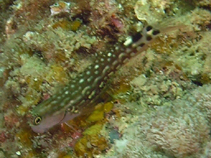| Family: |
Blenniidae (Combtooth blennies), subfamily: Salariinae |
| Max. size: |
5 cm TL (male/unsexed) |
| Environment: |
reef-associated; marine; depth range 0 - 7 m |
| Distribution: |
Western Pacific: known only from the Philippines and Indonesia. |
| Diagnosis: |
Dorsal spines (total): 11-12; Dorsal soft rays (total): 12-14; Anal spines: 2-2; Anal soft rays: 14-16; Vertebrae: 31-33. Description: Dorsal fin XI-XII, 12-14 (rarely XI,12), with deep notch between spinous and segmented-ray portions; anal fin II,14-16 (rarely 14); pectoral rays 13-14 (usually 14); pelvic fin I, 3; caudal-fin segmented-rays 13-14 (usually 13). Body depth 4.4-5.2 at anal-fin origin. Vertebrae 9-10 (usually 10) + 21-23 = 31-33. Incisors and canines look very similar, 42-59; posterior canines 1 on each side. Lateral line without pores, terminates below dorsal-fin spines 10-12. Anterior nostril with cirrus on posterior rim only. Overall olive brown with light grey or cream markings; eyes with bright yellow ring around pupil and yelow streaks on iris, mouth corners dark ventroanteriorly; nape without spots but instead with stripes 2-4, dark, separated by pale spaces; stripe from opercle to anterior body dark, but may be indistinct or absent; pectoral-fin base vertical pair of yellow spots, followed posteriorly on body by two rows of spots and dashes, pale yellow, fainter posteriorly; body spots 4-5 rows, may also have diffuse banded pattern; spots near the tail, dorsal-fin posterior base brilliant white spot immediately followed by saddle-like black spot, caudal-fin base vertical pair of dark brown spots with brilliant white spot in between. Venter sprinkled with fine melanophores (in large mature males only). Males spinous dorsal fin sometimes with stripe, faint, fine, dusky, suprabasal. This species is diagnosed by the single, large, saddle-like dark spot on its caudal peduncle dorsal contour, which its closest relatives, the other members of the Oculus Group, lacks (Ref. 5296, 90102). |
| Biology: |
Adults are found solitary or in loose small groups in shallow waters 2-10 m deep, on steep gutters covered with algae (Ref. 90102). They occur in shallow waters, and are collected at depths less than 5 m. Oviparous. Eggs are demersal and adhesive (Ref. 205), and are attached to the substrate via a filamentous, adhesive pad or pedestal (Ref. 94114). Larvae are planktonic, often found in shallow, coastal waters (Ref. 94114). |
| IUCN Red List Status: |
Least Concern (LC); Date assessed: 25 March 2009 Ref. (130435)
|
| Threat to humans: |
harmless |
Source and more info: www.fishbase.org. For personal, classroom, and other internal use only. Not for publication.
